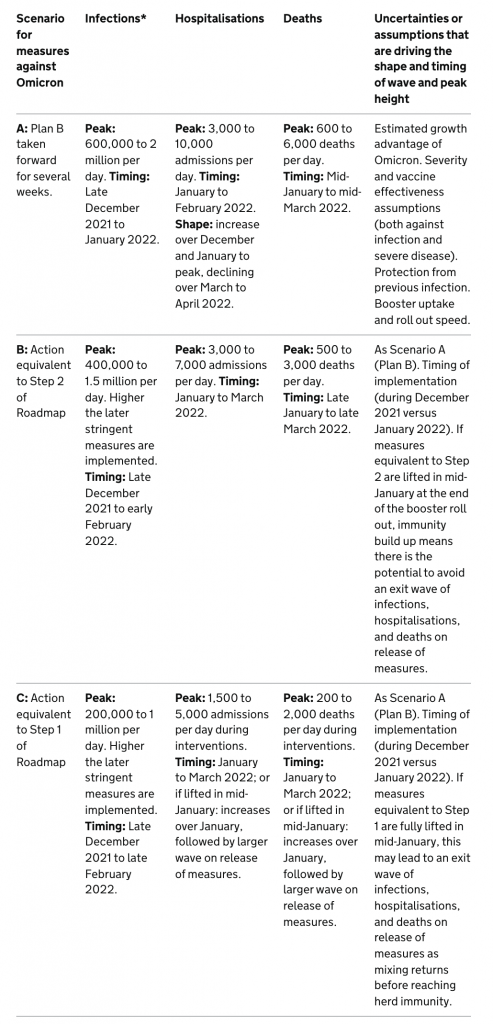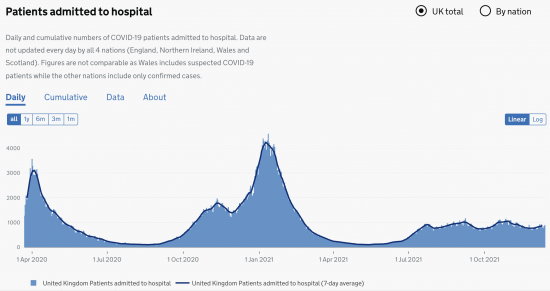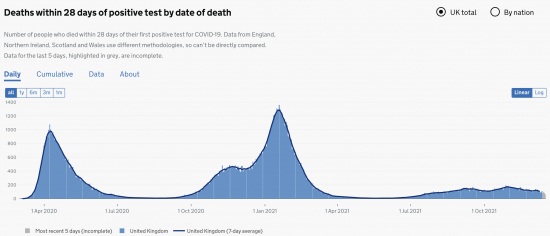I apologise for being the bearer of bad news on this last Sunday before Christmas, but the current economic outlook is dire.
I base this gloomy prognosis on the report of SAGE - the Scientific Advisory Group for Emergencies. They published a new report yesterday evening, although it was presented to the government on 15 December. The report is unambiguous. In the summary they say:
group">SPI-M-O has considered an updated range of scenarios from 2 academic groups who have modelled the impact of Omicron transmission on trajectories of infections, hospitalisations, and deaths. These groups suggest it is almost certain that there will be a very substantial peak of infections (much larger than occurred during January 2021). There are highly likely to be between 1,000 and 2,000 hospital admissions per day in England by the end of the year. Many of these hospitalisations are already ‘in the system' due to the lags between infection, symptom onset, and the subsequent need for health care. The recently announced expanded and expedited booster vaccination programme will not affect transmission and severe and mild disease in time to mitigate these hospitalisations for the rest of 2021.
Scenarios that assume no further restrictions beyond Plan B generally lead to trajectories in daily hospital admissions in England that have a minimum of 3,000 hospital admissions per day at their peaks, with some scenarios having significantly worse outcomes during the first few months of 2022. To prevent such a wave of hospitalisations, more stringent measures would need to be implemented before 2022.
I have added the emphasis but in other parts of the report they added similar emphasis to make the same sort of points.
SAGE modelled three scenarios, with the following results:

In the first scenario existing precautions are maintained. No significant behavioural change is assumed. The second scenario is the reimposition of social distancing, much wider enforce mask-wearing plus outside drinking and eating, but no proper lockdown. The third scenario effectively assumes a return to a lockdown.
Midpoint admissions to hospitals are
Scenario A 6,500
Scenario B 5,000
Scenario C 3,250
The NHS has a capacity of 140,000 beds at most, which will be massively challenged by Covid restrictions and staff ill health which is already running at very high levels. The likelihood that it can handle 3,000 Covid admissions a day on top of other work is very low. This is data to date from the UK Covid tracking website:

There was a brief period in January 2021 when admissions hit almost 4,000 a day. That was exceptionally difficult to manage, and this might now be the best-case scenario for 2 to 3 months.
Deaths are off previously known scales. Again I note mid-points:
Scenario A 3,300
Scenario B 1,750
Scenario C 1,100
This is data to date:

The January 2021 peak might be sustained for two months.
It could also be very much worse. Indeed, without action being taken the messages and ambiguous. Deaths will happen at an unprecedented rate. A simple extrapolation of the scenario A data (and I know all about the risks of doing this) suggest that 200,000 deaths might be possible.
If you can brace yourself for it the rest of the report is worth reading. This might be key:
To significantly reduce the peak of such a wave, more stringent restrictions than the current Plan B measures would be required. To illustrate more stringent measures, groups have modelled impacts comparable to Step 2 or Step 1 of the Roadmap for England. These scenarios suggest that, if sufficiently stringent and enacted early enough, measures and or behaviour change would not need to be in place for more than a few weeks to substantially reduce the potential peak in hospital admissions and infections compared with Plan B alone. The timing of such measures is crucial; if implemented late, it is less likely that these would prevent considerable pressure on health and care settings.
Reducing the total number of infections and delaying any wave in the very short term would allow more time for the accelerated booster roll out to take effect. This would also allow many hospitalisations to be prevented as a result, not just delayed.
The first emphasis is mine, the second was theirs.
I have little doubt that SAGE required that this report be published now to protect them from the personal risk that they might be prosecuted in the future for failure to act when it was possible to do so to prevent death, long-term illness and major impact on society. If that was their motivation, then I can entirely understand it.
I also suspect, however, they also wished people to know what they expected the government to do. They are demanding further action to prevent the spread of disease now. What they are saying is that there is no possibility of delaying that action: time is of the essence. As the paragraph that I quote also makes clear, what they are saying is that unless that action is taken then people will die unnecessarily as a direct consequence of the failure to take appropriate action at this moment.
Despite this, as I write, Sajid Javid is touring television studios declaring that no further measures are required. Of course, with this government that means nothing. It U-turns so often that a denial this morning could well be the precursor to the action this afternoon, but as yet the man responsible for healthcare in England is saying that in the light of this evidence he does not think that action is needed.
I record this for two reasons. Firstly, because I think that the record requires that I do so. Like SAGE I need to be able to say at some time in the future that I appreciated the scale of the crisis that we were facing, and demanded action. Second, and much more significantly, what this forecast data suggests is that we are going to face a larger economic crisis in 2022 than any that we have faced over the last two years. SAGE is unambiguous. They are saying that this is the worst wave of Covid yet and that we are in a much worse position than we were in March 2020.
I interpret that in three ways. Firstly, in the short term, the sheer scale of sickness that is going to sweep through the country is going to create economic mayhem.
Secondly, unless the government acts to protect people from the consequences of this then this will be catastrophic for the economic health of people, employers and the country as a whole.
Third, this does then require action immediately. People have to know what is expected of them, and that they can rely upon the support of the government so that they can afford to act in an appropriate manner, including with regard to the change in their plans for Christmas, if those are required.
That then leads to the necessary conclusion of this discussion (there will be others to follow, particularly on what the government should be doing now) which is that unless the government acts today to lock down the country to protect us from the risk of extraordinary consequences from this crisis those making that decision should be culpable for the deaths that follow, which they now know are preventable.
If they act we will know that there is some vestige of responsibility left in government in this country. If they do not we will know that we have a government that has abandoned the social contract. What it will be communicating in that case is that it has ceased to accept responsibility for the fundamental task of government, which is and has always been the protection of the people for whom a government is responsible.
To describe today, and the decisions that will be taken during its course, as pivotal to not just what happens in 2022, but to the longer-term with regard to the political economy of this country, is an understatement.
And I am not optimistic.
Thanks for reading this post.
You can share this post on social media of your choice by clicking these icons:
You can subscribe to this blog's daily email here.
And if you would like to support this blog you can, here:



So firstly, the government has suppressed this report for four days. This is the equivalent of turning off the air raid sirens when you see the blips on the radar screen. Then I read the resignation statement by Frost today, lauding England as the free-est country in the world and “long may it remain so.”, while lamenting policies that are “not making the most of opportunities presented by Brexit.”
Leadership matters and this is the political and economic level of England’s. Here we have it again. An intelligent, well educated high profile player so driven by ideology that it has entirely blotted out reality. The Sage report is indeed dire, but this adds a layer to the crisis that is truly desperate. I am left looking for the positives and the diversity of Strictly (which I personally do not like or watch) seems a beacon of hope in a society, the government of which is steeped in anti wokism utterly at odds with this heartening social reality. Wiil the moron element of government peak in tune with Omnicron!
[…] to look at the data and why I am so worried it could be worth reading my blog post on this, written […]
Agree totally, we need strict lockdown now with all precautions. I thought this crisis wouldn’t be until mid-January but now the evidence is overwhelming to take immediate action. The public is more aware of the danger than the government and will willingly follow new rules despite the Christmas inconvenience.
The people are already ahead of the government. As soon as the highly infectious nature of omicron became apparent, many older/informed folk cut back on social activity. Chris Whitty’s suggestion about prioritizing the contacts matter cut through to people in a way that rang true – and we know it did because of all the cancellations that are happening even though not required by government. Add to that the bizarre rebellion against COVID measures that to most folk seem self evidently needed (even if too little, too late) and you have a government that has completely lost the plot.
When Nadine Dorries is excluded from a Tory Whatsapp group for being the “adult in the room” then you know the wheels have come off!
We run the real risk that sick people will not get anything close to a level of treatment needed – left at home to suffer, stacked up in hospitals without the staff to care for them etc.. Can a government survive that? Surely not.
I sincerely hope not
I would find that account more convincing if I had not just observed the Conservative backbenchers voting against the new measures, and then following classic Conservative procedure; heap all the blame for every single failure, bad decision, dithering, irresponsibility, sleaze, corruption and incompetence on the head of the PM alone; threaten to dump him, and bring out the new strategy to replace gems like ‘Get Brexit Done’, ‘Eat out to Help Out’, ‘TINA’ or whateve; with the old dependable saviour of the Conservative Party through the ages: ‘Nuthin’ to do with me, Guv’.
And Johnson is blaming the media. Akin to nuthin’ to do with me gov. Anyone but him, even when he tries to make it look as though he is taking responsibility. Gives with one hand and takes it away with the other, as it were.
Not enough seems to be known about Omicron and its potential severity at this point. It makes sense to have hard facts and figures before taking drastic action such as lockdowns. It is right that mask wearing in shops has been reintroduced and hopefully this will pay dividends.
No one knows the future. Data on death rates etc are at least 4 weeks away….Having another lockdown based on ifs, buts and maybes seems excessive to me, considering the impact that could have on the economy, confidence and people’s mental health.
To be blunt, you are very, very wrong
Nor do you seem to understand that when life is at risk a precautionary principle applies
I hope you will be happy to accept personal responsibility for tens, if not hundreds, of thousands of deaths for advocating this course of action
That is depressing but thanks for telling us what the media is concealing.
It does feel like that last scene from Blackadder Goes Forth – the population has been nudged to accept mass death which would have been unthinkable last year.
My public sector workplace as gone for the unprecedented step of asking us to reduce our exposure to the virus by cutting down on socialising etc., because the CEO is worried that no one will be in to run the service in the New Year.
As for people’s mental health – I note that the fucking advertising industry is still selling stuff isn’t it – selling dreams, aspirations, holidays, consumption, cars on empty streets and roads, idealised families and perfect looking men and women etc.,
There’s your effing mental health problem engine – right there in the advertising that gets rammed down our throats 24/7.